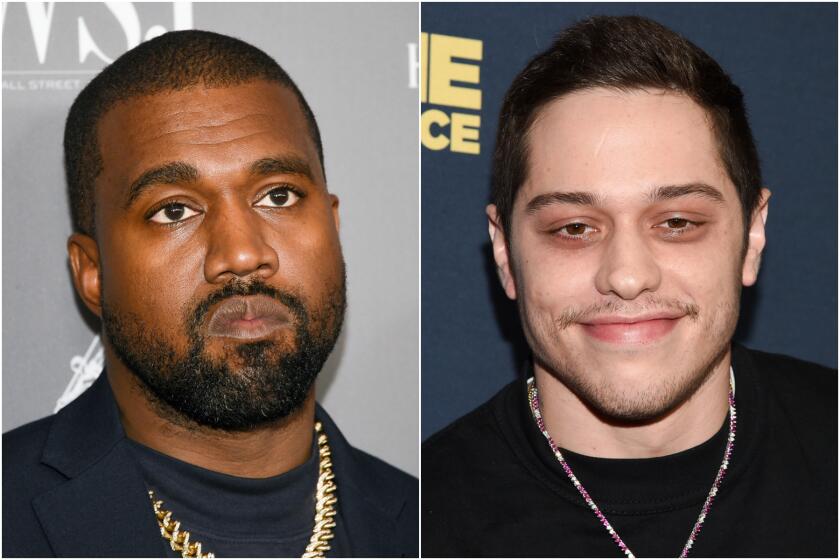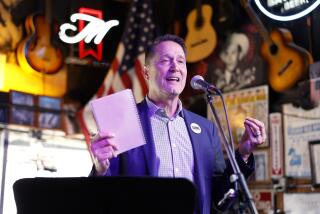Did Ye’s revenge music video go too far?

YouTuber Ethan Klein is familiar with the boundaries for what you can post on social media. His legal battles have set precedents for commentary and fair use on the platform. For him, the latest music video by the rapper formerly known as Kanye West might have gone too far.
“I’m not sure you can threaten to kill someone even in a music video,” Klein said in his live “Off the Rails” YouTube show Wednesday, which included three hours of wide-ranging pop culture commentary. After several seconds of watching a claymation Ye hold a severed head and drag a wrapped-up body across the screen, Klein asked to stop the video.
“I don’t even think this video should be allowed online,” he said.
In the music video for the song “Eazy,” Ye, who has been in a bitter divorce battle with his now ex-wife, Kim Kardashian, appeared to kidnap, bury and decapitate a clay figurine resembling her new lover, Pete Davidson. The video released Wednesday triggered a widespread backlash online and is proving to be yet another test of what is acceptable on social media at a time when tech companies are facing mounting pressure to remove offensive material from their sites.
The claymation video for Kanye West’s ‘Eazy’ depicts the rapper kidnapping and beheading a figure resembling Pete Davidson, who’s dating Kim Kardashian.
“The video itself without context I probably would have chalked up to artistic expression and hyperbole,” said Emily Baker, a former deputy district attorney for Los Angeles County who is now a YouTuber. “With all of the context around it, it becomes much more threatening.”
Baker added that Ye’s actions could count against him in a protective order or in family court. A spokesperson for Ye declined to comment.
The video was released the same day that a Los Angeles court granted Kardashian’s wish to be legally single and move on from her seven-year marriage to the Grammy winner.
Kardashian recently told the court the rapper’s recent behavior was causing her “emotional distress.” He has been broadcasting the behind-the-scenes drama with his reality star former wife, sharing screenshots of their private correspondence and complaining about lack of access to his children.
In private screenshots Ye posted, Kardashian texted that he was creating a “dangerous and scary environment” for Davidson with his song lyrics and public comments.
The two men lay motionless on the sidewalk outside a South L.A. carwash, pools of blood spilling from their heads.
Despite the public reaction, which also included some voices of support for the singer, some legal experts did not see the music video as rising to the level of breaching California’s criminal code.
Section 422 of the code makes it a crime to communicate a threat to do something that can result in great bodily injury or death to someone. But some attorneys said a claymation music video would not meet that threshold.
“There certainly lacks the seriousness to the type of threat that these statutes tend to recognize,” said litigator William Delgado, a managing partner with DTO Law.
At the end of the video, words flash across the screen referring to everyone living happily ever after except “Skete”— a nickname that Ye has used for Davidson — followed by “JK he’s fine.”
“[That] would go to helping to defeat any claim that this was meant to be taken seriously and consequently could constitute a true threat,” said Douglas Mirell, a 1st Amendment attorney with Greenberg Glusker.
But even without that disclaimer, the cartoonish nature of the video indicates it’s not a serious threat, legal experts said.
“It’s claymation, it’s his expression, there’s nothing realistic about it. I don’t think it’s like a call to arms to go out and attack Pete Davidson,” said Daniel Rozansky, an entertainment litigation partner at law firm Stubbs Alderton & Markiles. “I think it’s more tame than many of the movies or video games that we watch.”
There have been other parodies depicting violence against celebrities. For example, one of MTV’s popular programs was “Celebrity Deathmatch,” in which claymation versions of popular celebrities would be decapitated and torn apart.
Ye uploaded the video on Instagram and then others shared it on different platforms, including Twitter and YouTube.
These social media companies have content policies, such as rules against posting violent content, and violations can result in getting kicked off the service.
“Serious threats of harm to public and personal safety aren’t allowed,” according to Instagram’s community guidelines. “This includes specific threats of physical harm as well as threats of theft, vandalism, and other financial harm.”
Twitter’s rules state, “You may not threaten violence against an individual or a group of people. We also prohibit the glorification of violence.”
Twitter, Instagram and YouTube did not immediately respond to requests for comment on whether Ye’s video violates their policies.
Baker believes the video does breach Instagram’s terms of service because the threat “has been specifically made against Pete Davidson and disturbingly showing him being beheaded and buried.”
But social media companies are not legally obligated to take the material down, legal experts said. They enjoy broad legal protections, not only from creators if the content is taken down but also from any claimants who may want the content removed.
“[It’s] very difficult for somebody to bring a claim against them on the basis of the content,” Delgado said.
Social networks have been under pressure to quickly react to offensive or dangerous material on their sites, a tricky and challenging endeavor to navigate amid a worldwide pandemic, the last presidential election and, most recently, Russia’s invasion of Ukraine and concerns about disinformation spread by Russian statecontrolled media outlets.
Several large companies have scaled up their content moderation efforts to address these issues.
“Content moderation at scale is impossible to do perfectly and nearly impossible to do well,” said David Greene, civil liberties director at the Electronic Frontier Foundation. “The volume of decisions that have to be made is enormous and the pace at which they have to be made is very fast.”
Not all music is protected under the 1st Amendment. In 2018, the Supreme Court of Pennsylvania upheld a decision that rap artist Jamal Knox could be held criminally liable for lyrics that name specific police officers and list how he would harm them.
In that case, the circumstances surrounding the Knox case dealt with lyrics written about the musician’s arresting officers who were going to be witnesses in his case, said entertainment litigator Devin McRae with Early Sullivan Wright Gizer & McRae.
“You can see that there are a lot more circumstances that would lead one to believe it’s a true threat,” McRae said. “I think [Ye’s video] would most likely be seen to be perhaps in bad taste but not legally actionable.”
More to Read
Inside the business of entertainment
The Wide Shot brings you news, analysis and insights on everything from streaming wars to production — and what it all means for the future.
You may occasionally receive promotional content from the Los Angeles Times.













